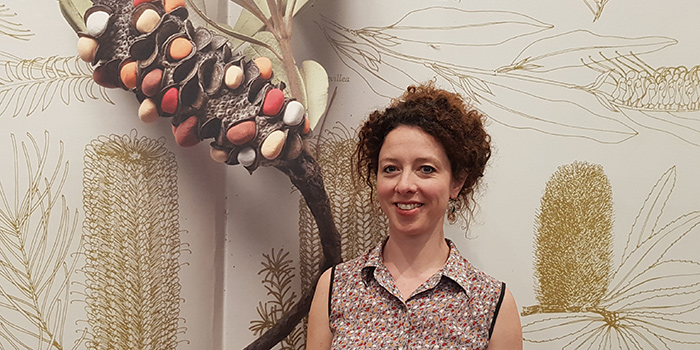Dr Barbara Lemon is no stranger to NSLA, having spent four years as Program Coordinator before heading overseas to broaden her library experience. We asked what brought her back to NSLA, and her thoughts on the organisation’s future.
Tell us about your background and your career path to becoming NSLA’s Executive Officer.
My parents were archivists when they met, and I was raised with a reverence for the record. I studied Australian history, tutoring at the University of Melbourne until I completed my PhD in 2008. In the breaks I travelled around Victoria with university colleagues, running sessions for Australian history students in regional schools. Our job was to reignite their interest through primary sources: a handwritten poem, a sketch, the pipe and letter found in the pocket of a murdered teenage convict in 1848…better entry points than rote-learned prime ministers.
At the university’s eScholarship Research Centre, I created entries and online exhibitions for the Australian Women’s Register – one of the first databases to be harvested into Trove. I began producing documentaries for ABC Radio National’s Hindsight program, using interviews and archival material. There were some wonderful experiences in that. Coffee and three-hour conversations about art, money and Sufism in Barbara Blackman’s kitchen. Cruising the grounds of Cruden Farm in a golf buggy with Dame Elisabeth Murdoch at the wheel. Driving the highway from Menindee to Broken Hill in 42-degree heat with Beryl Carmichael of the Ngiyaempaa people, eyes fixed on the giant slag piles beside the zinc mines as she told me how the miners had cut into the belly of Mother Earth.
After a couple of years in education policy and research with the Foundation for Young Australians, I received a Creative Fellowship at State Library Victoria. From there I began working with NSLA. It was a fantastic four years with Kate Irvine at the helm and more than 100 NSLA project members across Australia and New Zealand, deep diving into everything from copyright law to digital preservation. I crossed the ditch in 2015 to run our digital citizenship seminar in Wellington and loved the place so much I stayed on, working with library staff and the cultural sector to feed into a new strategic direction for the National Library of New Zealand.
Last year I took up a six-month contract with the British Library to lead their contribution to the European Commission-funded FREYA project, improving systems for persistent identifiers in research data. It was hugely valuable to understand first-hand the particular issues of colleagues in Europe, the UK and the United States, and to see that collaboration can work on a large scale where there is sufficient motivation and goodwill.
It’s a privilege now to bring these lessons home.
What drew you back to NSLA?
Two things: the purpose and the people. There are few sectors or industries underpinned by such a worthy purpose as libraries. That includes open access to knowledge, education, empathy-building, sparking creativity, sharing and preserving our human heritage. Right now I think the need for these things is as great as it has ever been. NSLA is an exceptional example of collaboration in the sector. As a collective it has achieved great things for the nation and for member libraries, driven by some generous-spirited people. I would like to see it retain its strength and build its influence.
What aspect of your job are you most excited about this year?
I am very excited about the prospect of launching a national edeposit service for Australia, the result of an unprecedented level of cooperation and co-investment from NSLA libraries, and several years of sheer hard work by teams across Australia. This is a wonderful initiative for publishers, libraries and the public alike. It will ensure that we have a comprehensive legal deposit collection accessible now and preserved for future use.
Where do you see NSLA in five years’ time?
In five years’ time I would like to see NSLA recognised nationally and internationally as a thought leader and a courageous agent for change in the library sector. Not change for change’s sake, but where change is due. I would like to see our work upheld as a vindication of the concept of collaboration.
Although we are not a membership organisation per se – our members are the national, state and territory libraries of Australia – we can and do operate in the interests of libraries everywhere. We have a close relationship with ALIA and the members of GLAM Peak and will continue to work with and advocate for our cultural sector colleagues. I think we can afford to be a little louder about that.
You’ve worked in and visited libraries around the world – do you have a favourite?
Funnily enough, a lot of my work with libraries has taken place over the web conference screen! It’s hard to beat the extraordinary exhibition displays at the British Library, of course, or the majestic surrounds of the Bibliotheque Nationale de France, but without a shadow of a lie my favourite library remains State Library Victoria.
The building is as wondrous and beautiful to me now as it was as a child, when I followed my father up the marble stairs into the hushed, dim-lit splendour of the domed reading room, where readers hunched in creaking wooden chairs and green lamps illuminated the pages of books with mysterious contents. It was hard to believe this place belonged to all of us – and it still feels like home. I look forward to seeing the renovations revealed later this year and next.










